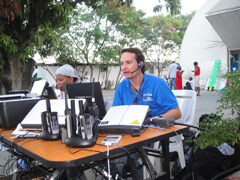The Cutting Edge of Medical Technology Content, Community & Collaboration
As reported in MedScape Today ... Just days after a devastating earthquake struck Haiti on January 12, medical volunteers from the University of Miami in Florida arrived and set up a tent hospital in Port-au-Prince. Along with drugs and other medical supplies, the healthcare personnel brought a vital link to the rest of the world.
"Everything was destroyed over there, and in the first days there was no Internet in Port-au-Prince," team member Antonio Marttos Jr, MD, assistant professor of surgery at the University of Miami School of Medicine and director of trauma telemedicine at Jackson Memorial Medical Center's William Lehman Injury Research Center in Miami, Florida, told Medscape Medical News. "But we were able to connect to our trauma center in Miami."
 |
| Dr. Antonio Marttos Jr using the portable satellites at the University of Miami's tent hospital in Port-au-Prince, Haiti. Photo courtesy of the University of Miami School of Medicine. |
Thanks to 2 donated portable satellites, the medical team consulted in real time with their Florida colleagues 700 miles away. The size of a computer laptop, each device contained a satellite telephone, satellite Internet, and video camera. "It was the same type of satellite dish that CNN was using to broadcast," Dr. Marttos said...
... Telemedicine experts say that high-tech advances in equipment make global telehealth possible and that use of this technology can improve diagnoses, speed treatment, and lower costs. It also comes in handy when a disaster has damaged or destroyed other communications...
telecommunication, according to team leader Michael Ashburn, MD, MPH, MBA ...
... Using a camera on a cell phone with Internet access, they took photos of patients' X-ray films and wounds and emailed them to stateside specialists, including a pediatric trauma surgeon ...
Read on at: http://www.medscape.com/viewarticle/717232?sssdmh=dm1.592277&sr...
CC
Views: 30
© 2025 Created by CC-Conrad Clyburn-MedForeSight.
Powered by
![]()